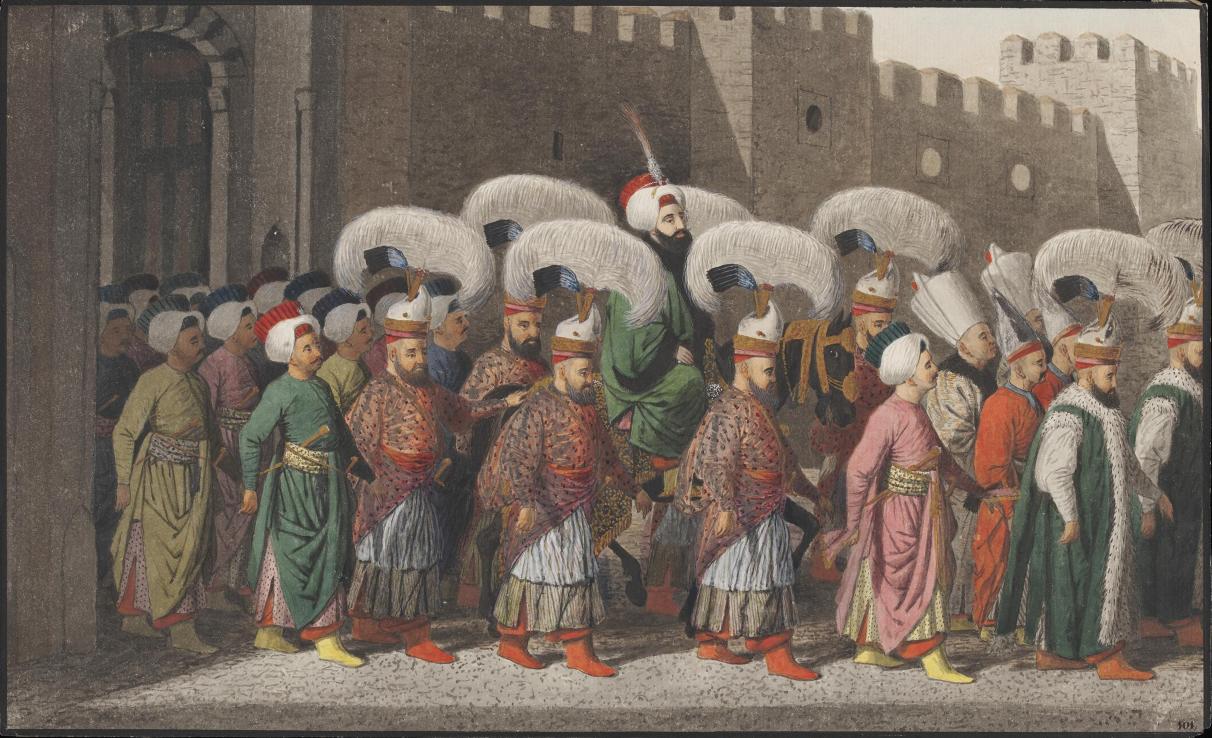Illustrations of Ottomans circa 1809 from
Stratford Canning's Pictures of Turkey
The Sultan riding out in procession to Friday Prayers

A larger image of The Sultan riding out in procession to Friday Prayers. Stratford Canning's Pictures of Turkey.
Physical description: The Sultan on horseback, surrounded by his retainers on foot, coming out of the doorway to the Palace.
Object: Watercolour
Place of origin: Istanbul, Turkey (Painted)
Date: about 1809 (Painted)
Artist/Maker: Anonymous Greek artist (Painter)
Marks and inscriptions: Numbered 101
Dimensions: Height: 21.6 cm, Width: 35.5 cm
Every Friday the Sultan would ride out in procession through the streets of Istanbul, accompanied by his escort of guards on foot.
He attended Friday prayers in an Imperial mosque, the day that the hutbe or sermon was preached. Here Sultan Mahmud II (born 1784, ruled 1808-39),
is seen emerging from the gate of his palace, Topkapi Sarayi, nearly hidden by his guards [Solak] with their elaborate ostrich-feather headdresses,
and other officers of the guards and his officials.
Victoria and Albert Museum. Museum number: D.88-1895
This procession is described in the Travels of Ali Bey: "On each side of the Sultan were four officers, who may be called the skreens of the Sultan, on account of the immense plumage they wore upon their heads, which so hides the person of his highness, that it is difficult to obtain a sight of him."
The 14th, 49th, 66th and 67th ortas of the Janissary Corps were called haseki [privileged] ortas (Eyyûbî Efendi Kanûnname, p. 43). Janissary hasekis, both on foot and on horseback, were established during the reign of Sultan Mehmed the Conqueror in order to hunt and keep hunting dogs in the sultan's entourage. Each of these privileged and respected ortas had a commander called "haseki agha". They would accompany the sultan on his way to the mosque, walking on the right and left of his horse.
Source: Islam Ansiklopedisi
Later, 12 people were chosen from among Solaks and Peyks, and they were assigned to walk on both sides of the sultan's horse on ceremonial days. On the day of the ceremony, rikap solaks would wear a red fez over which a silver-embroidered cap and a silver holder with white and coloured feathers in it. A kalendra made of black and white feathers was added to this part called zivana. Since these people are responsible for the flamboyant and beautiful ceremony, their clothes are meticulous. Rikab solaks were chosen from among the most senior solaks.
Source: Osmanli kiyafet albümleri (1770-1810) by Nurdan Küçükhasköylü
Compare the 6 guards marching beside the sultan's horse with:

34 Rikiap sobaï : l'homme chargé de marcher à côté du cheval du sultan
in Costumes Orientaux, an album owned by Joseph Gabriel Monnier
Previous: 95. Janissaries with soup kettles and the regimental spoon Next: 5. A Solak or Kulkethüdagasi
Back to Illustrations of Ottomans circa 1809 from 'Stratford Canning's Pictures of Turkey'


